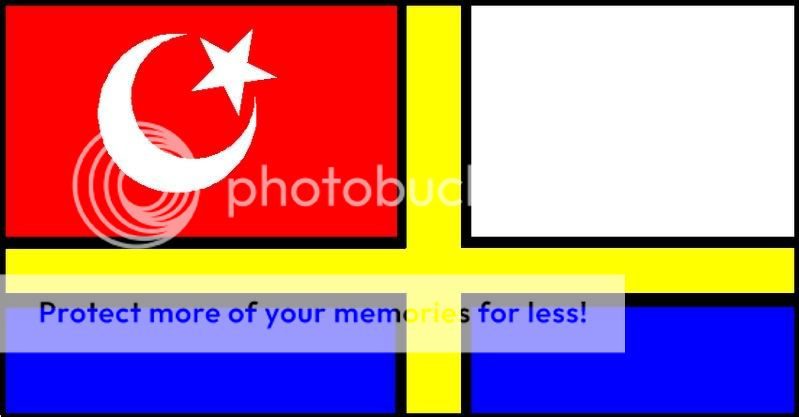Flag of the Teutonic Kingdom of Dacia. The black cross represents the Teutons and the surrounding shields represent the four original Vlach princedoms. The white eagle and symbols on the shield represent the particular heraldry of the original lands of which the current Kingdom now occupies. The three colors represent the main ethnic groups and constituent peoples: black-and-gold for the Germans (Teutons) and the gold-and-purple of the Vlachs (Dacia).
The Teutonic Order State, established by order of the King of Hungary and with the blessing of the Pope in 1221, in order to conquer the "heretic" (Eastern Orthodox) lands south of Hungary for Catholicism. At one time, the Order State encompassed the entirety of Wallachia, Moldavia, northern Bulgaria, and Serbia. One reason for this success was the influx of German catholics, enticed by Byzantine riches "liberated" from Orthodox lands. The German colonists soon outnumbered what native Vlachs remained, as most of the Vlachs were expelled.
However, the survivability of the Teutonic Order State was jeopardized when the Ottoman Empire conquered a significantly weakened Byzantine Empire in the 1450s. In order to consolidate his lands in the face of this growing enemy, the Grand Master of the Order, Ludwig von Erlich, declared himself
Duke of Dacia, with the consent of the King of Hungary, in 1466, and secularized the Order and its lands into a monarchic duchy. However, high-ranking clergy who now became somewhat disenfranchised by Ludwig's consolidation conspired against him, and assassinated the Duke in 1468. The ensuing confusion and lack of coordinated leadership led to the conquest of the Order State in 1471. However, the Germanic population remained.
The region as occupied on-and-off by Hungarian, Austrian, and Ottoman armies over the next four centuries, until it definitively came under Austrian control in 1769. In the mid to late 1860s, as a result of Austria's defeat in the German Unification War by the Hanover-Bavaria--Saxony coalition, the Habsburg monarchy, and the Holy Roman Empire, began to crumble. The Austrian King divided his lands, and separated Austria, Bohemia-Hungary, and Dacia/Rumania into separate lands, ruled by his sons or brothers. The new Teutonic Kingdom of Dacia was formed, in the memory and basis in the old Order State, populated about half and half by ethnic Teutons and ethnic Vlachs. Over time, as the Ottoman Empire weakened in Europe, Dacia came to rule much of the northeast Balkans. Today, it encompasses much of the historical regions of Wallachia, Moldavia, Transylvania, Dobruja, and Moesia, and has a democratic federal government with a constitutional monarchy, headed by King Louis VI, of the house of Habsburg. The population is primarily made up of Catholic Teutons, Eastern Orthodox Vlachs, and a minority of Eastern Orthodox Slavs.



